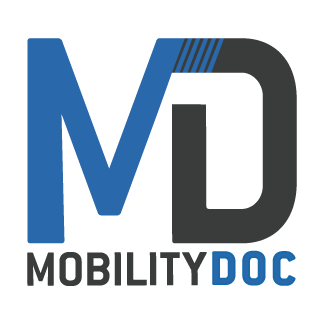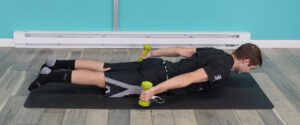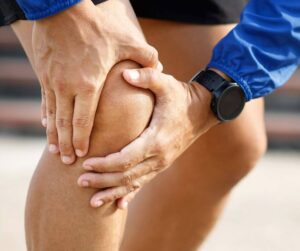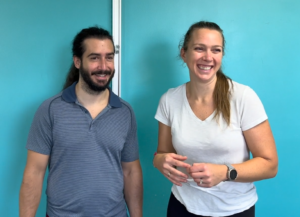A few weeks ago we shared 6 at home methods you can use to treat your achilles tendonitis. This week we are deep diving into the anatomy of the calf and achilles to gain a better understanding of what’s going on. On top of that, get ready for a behind the scenes look at how we would treat achilles tendinitis like you’re one of our own patients.
The Anatomy of Achilles Tendinitis
To better understand how Achilles tendinitis develops, it helps to know the key components involved:

- Gastroc-Soleus Complex: The gastrocnemius and soleus, are what we typically think of as the calf muscle. Layered on top of each other, the soleus lies underneath the gastroc. The gastroc has 2 heads on it and attaches into the achilles (this is important for treatment purposes). Together, they generate the force necessary for walking, running, and jumping.
- Achilles Tendon: A tendon’s job is to connect a muscle to a bone. This strong tendon connects the gastroc-soleus complex to the calcaneus (heel bone). The Achilles tendon allows for efficient transfer of force during movements like walking and running, making it one of the most important tendons in the body.
- Calcaneus (Heel Bone): The Achilles tendon attaches to the calcaneus at the back of the foot, just above the heel. The stress placed on the Achilles tendon over time can become inflamed and irritate at the attachment point. This inflammation and pulling is a common pain people feel when dealing with achilles tendinitis.
Common Mistakes With Recovery
- Starting with Strengthening – A lot of patients that come into the office will have tried something like calf raises to help heal their achilles tendinitis. While strengthening is an important part of rehabilitation, it’s not first! You need better length of the calf for pain free movement and less irritation through the tendon.
- Only stretching – Stretching is another important part of overall health to the calf muscle however, it only targets the calf and a small portion of the achilles tendon. Where many people feel discomfort is often right above the heel. This part of the tendon doesn’t receive as much positive impact from stretching. That’s why it’s really important to do the corrective techniques we’re about to share!
How To Effectively Treat Achilles Tendinitis
In our clinic we have helped many patients successfully recover from achilles tendinitis. Here’s a breakdown of how we would treat you if you were in our office:
Cross-Friction Massage

This technique is done by hand with your thumb and forefinger. You want to pin the skin on both sides of the heel and then move in very small movements while keeping pressure. This pressure is to your tolerance.
We begin cross-friction massage around the heel bone, slowly traveling up along the Achilles tendon. This technique helps break down scar tissue, stimulate blood flow, and promote tissue repair. By applying direct pressure to the tendon in a back-and-forth motion, we encourage healing and reduce stiffness in the tendon. You want to do this both horizontally and vertically to the area for 1 minute in each direction. A place that can get particularly sore is the inside part of the heel.
Deep Tissue Massage
Next, we focus on deep tissue massage through the gastrocnemius and soleus muscles (the calf muscles). These muscles are most likely going to be tight. Similar to cross friction massage you’ll apply pressure with your fingers.

We learned above that the gastroc has 2 heads that attach to the tendon. This meeting point is usually tender and a great place to work through. To make this effective you need to push on the muscle and pull in one direction or the other. You can pull both towards the outside and the inside as well as go right through the center of the muscle belly. Take your time and don’t go too quickly through this. it’s important to work through the entire muscle, not just the spots that hurt! By releasing tension in the calf muscles, we improve flexibility and relieve strain on the Achilles tendon itself.
Muscle Scraping (Graston Technique)


We finish by using muscle scraping, also known as Graston or instrument assisted soft tissue massage. We’re going to work through both the calf and the achilles tendon. This involves using specialized tools to “scrape” the surface of the tissue, which helps to further break down scar tissue, improve circulation, and promote faster healing. This pressure is again to your tolerance. Deep bruising doesn’t mean effective treatment. We are trying to positively impact the tissue fibers not damage them. If you’re looking for a muscle scraping tool we love Sidekick! Learn more about them here. Ready to buy? Order Here!
Pro Tip: Bend the knee while muscle scraping the calf and you’ll get deeper into the soleus muscle. This is often hard to get to!
How Often Should I Use These Techniques
Our goal is to get you back to doing what you love as quickly as possible. That being said, you don’t want to rush things. You may start feeling better quickly however it takes 4-6 weeks to make a real change in the tissue fibers. Consistency counts! You can do this every day or every other day. It really depends on how your body responds to treatment. If it’s feeling too sore, stick with every other day!
Through a combination of therapies you can target the root causes of your achilles tendinitis. Whether you’re dealing with the early signs of discomfort or have been struggling with chronic pain, we’re here to help you regain mobility and strength. For more detailed information make sure you check out the video above on how to treat your achilles. Feel free to reach out on any of our social media channels and ask any questions you may have!
Watch Our How To Video on Treating Achilles Tendinitis
Why Choose Mobility-Doc For Your Achilles Tendinitis Treatment?
When you come into Mobility-Doc we treat everyone as the individual you are. Every injury is unique and comes with specific treatment. If you’re experiencing Achilles pain, don’t wait. Contact us today to schedule an appointment at either our Bethlehem or Stroudsburg locations and begin your journey toward recovery.
Unlock Your Body’s Potential with MDRx: Full Body Mobility Program!
Are you feeling stiff, restricted, or limited in your movement? Our Full Body Mobility Program is designed to help you break free and move with ease!
This comprehensive program focuses on improving flexibility, range of motion, and overall stability through your entire body. We target the main areas including back, shoulders, hips, and ankles. The best part is each day offers bite sized mobility work so it can fit anywhere into your day!
Join our MDRx: Full Body Mobility Program today and discover the freedom of effortless movement! Don’t let stiffness hold you back—take the first step toward a more mobile, active life!




